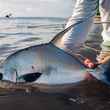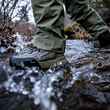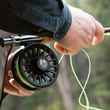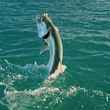Fly fishing is a visual craft. From the dry-fly take to the ubiquitous trophy photo, it’s a pastime that, for many, is best shared in pixels.
But, for generations, fly fishing photography and film was hopelessly analog — the early fly-fishing practitioners, for whom the video arts were their chosen medium, filled boxes of 8-mm film and, later, cases of VHS tapes, each packed with footage that, the instant it was recorded, began to degrade.
Early recordings by the likes of Lee Wulff, who saw some of his work air in prime time on CBS in the 1950s, along with more recent angling hijinks caught on film and tape were in danger of being lost or, at best, becoming largely unrecognizable thanks to age and decay.
Enter the American Museum of Fly Fishing and Alex Ford, the museum’s digital media director. Today, thanks to a conscious effort to preserve some of fly fishing’s most important visual history, many of the films and tapes from the past are now permanently preserved and protected in digital form.
“We felt that we had to do everything we could to preserve some of these films,” Ford says. “And it’s a part of our work to become more modern, to bring the museum into the 21st Century, where video is a huge part of fly fishing.”
Indeed, the museum has digitized hours upon hours of video footage dating back decades — footage that might otherwise have been lost. And it’s getting a major assist from the folks at Scientific Anglers — the company was in possession of lots of irreplaceable video episodes featuring celebrity anglers like Jim Teeny, Gary Borger, Lani Waller and Billy Pate, among others. It donated the old films to the museum, where Ford and his team set about digitizing them and protecting them for posterity.
“This was all long before social media,” said Brad Befus, president of Scientific Anglers. “There was some really great stuff done and it was in danger of being lost.”
SA, back when the company was owned by the 3M Corp., helped produce some of the most iconic fly fishing films of the day, including its Mastery Series that featured films like “Fly Rodding for Tarpon with Billy Pate,” and “Fly Fishing for Trophy Steelhead with Lani Waller.” It also produced the Sportsman’s Video Collection that featured episodes like “Fishing the Dry Fly with Gary Borger.”
When Orvis bought the SA brand in 2013, Befus worked with Orvis Vice president Jim LePage to digitize the Billy Pate tarpon collection for the museum – it was the impetus to start converting all of SA’s video library into digital versions, if, for no other reason than to ensure the longevity of the films. And, Befus said, the company had a lot of film and video footage.
“Thankfully, a lot of it was stored in a cool, dry place, and that likely protected some of the old 8mm masters we had so that they could be preserved in digital formats,” he said. And SA was in possession of some of the most iconic fly fishing films ever made, including “Way of the Trout,” that was produced for Trout Unlimited in 1969.
“Can you believe that the 8mm master of that film was just stored in a box at SA?” Befus said, laughing.
And, Befus said, it just made sense for SA to hand over all of its archival film footage to the museum – after Orvis bought the SA brand, it was a no brainer. The mothership Orvis store is right next door to the museum in Manchester, VT.
“So many anglers identify with those films,” Befus said. “I wore out the VHS tapes I had of Gary Borger showing us all how to fly fish for trout. And now, because it’s all been converted to digital, it’s out there for today’s anglers to view and hopefully appreciate. Things have come a long way in filmmaking, but I think it’s important that today’s anglers understand that there was some really great stuff made 40, 50 and even 60 years ago.”
If you think you know a thing or two about fly fishing, watch an old Borger film. There’s a reason he was a fly fishing guru to so many in the 1980s and 1990s.
Today, the museum is likely in possession of the largest fly fishing video and film library in the world, and the vast majority of it is protected in digital form that’ll never degrade or decay. And, yes, anyone can visit the museum’s website and get a sneak peak of some of the vintage recordings. For an annual $35 membership, today’s Instagram anglers can get access to the museum’s screening room, and check out some of the videography and cinematography that started it all.
“We’ve archived a lot of footage,” Ford says, “and we’re getting more in all the time. The collection is only going to grow, so we’re excited about it.”
Under Ford’s guidance, the museum has embraced the visual aspect of the craft, and by digitizing and preserving these iconic films and videos of the past, it’s giving today’s visual creators some perspective they might not have experienced otherwise.
But, as Ford notes, it’s not just about preserving the historic films and video. The museum has embraced digital and social media, and it’s even gotten into the video production game itself, helping produce films like “Mighty Waters,” the story of legendary Bimini bonefish guide Ansil Saunders who poled the Rev. Martin Luther King Jr. around the flats, and “Time,” a film that features angling legends Flip Pallot, Blane Chocklett and Bob Clouser as they remember the Godfather of American fly fishing, Lefty Krehy.
Ford and the team aren’t done yet. Recognizing that the museum is home to a significant collection of historically important fly fishing gear, they’ve started a new video series called “Fishing the Collection,” that features today’s anglers casting and fishing select gear from the museum’s vault of historic rods (it’s home to more than 1,200 rare and historically significant fly rods) and reels.
“It’s a cool way to contextualize vintage tackle,” Ford says of the museum’s new series. “And we can use social media, like Instagram and YouTube to reach more people and younger people and help them learn about the history of fly fishing, and about the museum.”
What else can be found in the newly created film and video vault at the museum? It’s the only online destination where anglers will find age-old classics, like “The Way of the Trout” or some classic fly-tying films featuring the likes of Bob Jacklin or A.K. Best.
And the museum has archived a collection of films titled, “Top 20: Influential Films of the last 20 years.” Indeed, the only place viewers can legally view the classic, “Running Down the Man,” the film that made East Cape rooster fish famous, is with an annual membership to the museum. Also in the top 20? The first-ever episode of “The Reel Adventures of Hank Patterson,” and the critically acclaimed film, “Red Gold,” that played a significant role in the protection of the Bristol Bay, Alaska, salmon and trout fishery.
“We’re definitely turning to film,” Ford continues. “It’s a conscious effort to modernize and hopefully show today’s anglers the importance of film and video to fly fishing’s history.”

































Comments